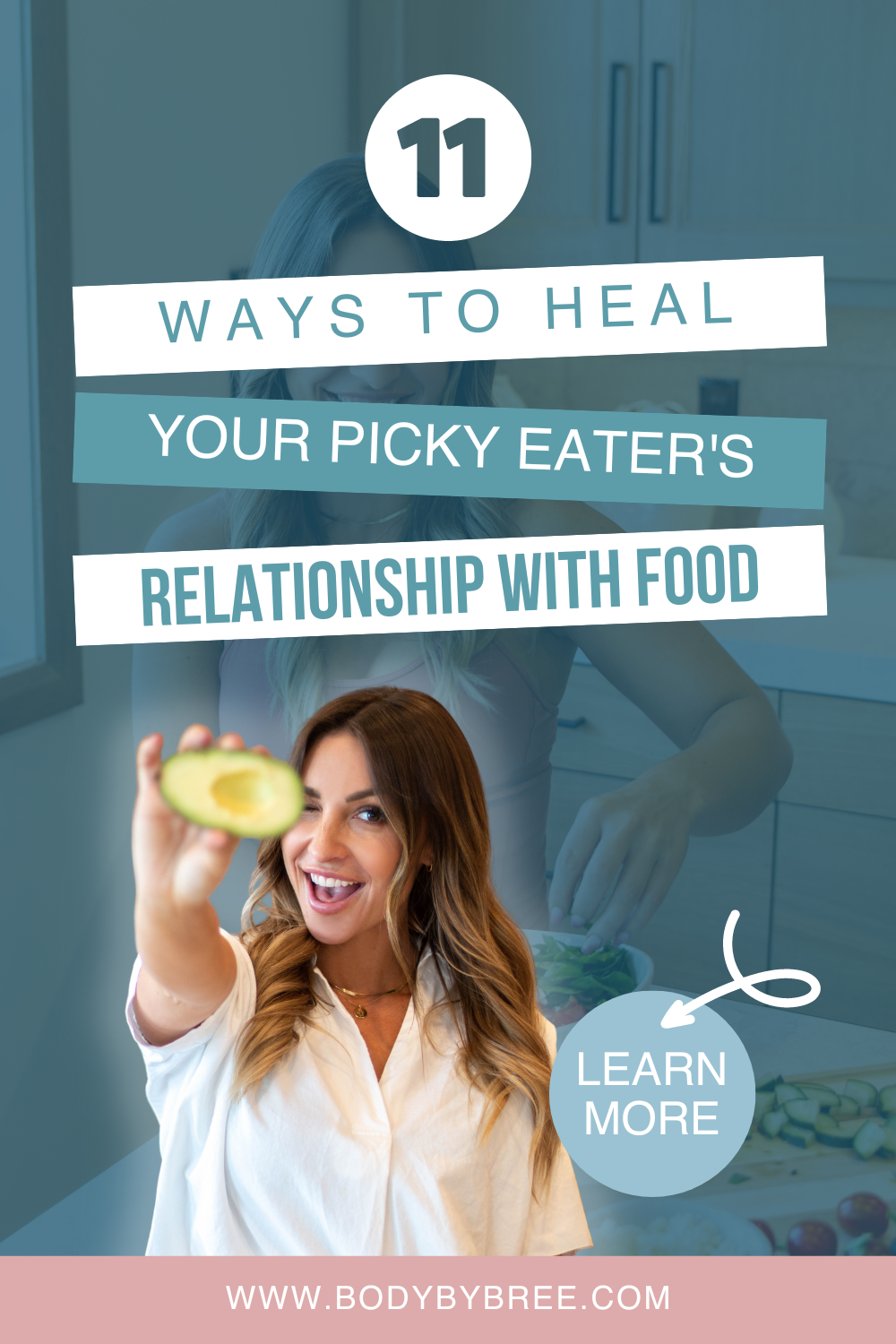
Creating a healthier, happier you.
HEAL YOUR PICKY EATER'S RELATIONSHIP WITH FOOD

Do you struggle having a picky eater in your home? Trying to make sure they are getting the nutrition they need in a positive way can be so stressful!
I even spend time trying to help heal many of my clients' relationships with food and we can do simple thing as parents to contribute to healthy habits (mentally and physically) around food for our kids. It's so much easier than you think!
In a recent podcast episode I sat down with Jennifer Anderson, MSPH, RDN, founder of Kids Eat in Color to talk through her top 11 tips to help parents of picky eaters.
Here are her top 11 tips to take the stress out of mealtime for you and your picky eater:
1. START WITH NO PRESSURE MEALS.
As much as we want to make sure they're eating all the right things, the more we pressure, the more they pull back and resist. Avoid getting into back-and-forth arguments with your toddlers by letting them know it's available. If they want to eat it, great. If not, that's okay too! Taking the pressure off of them takes the pressure off of you too.
2. LET THEM EAT IT WHEN THEY ARE READY.
When you say they can eat it when they are ready, you're just giving them permission to be in charge of what they choose to eat. This isn't only a good thing now, it's a good thing for their future! The goal is for our kids (and ourselves) to be in touch with our gut and our hunger cues. The more opportunities we give our kids to work through this for themselves the better they will be at it.
While it's important to avoid the "finish your plate" mentality, it's also important to remember that you're the parent! It's okay if they don't like everything you serve. It's best practice that you as the parent purposefully decide what foods are available in your home and let them decide if they are going to eat it or not.
3. HAVE OPEN AND CLOSED HOURS FOR THE KITCHEN.
You have to use a timer to make this work. Basically this just means that after mealtime is over, kids can't come back to eat something else because they didn't like the meal and want to snack. Try to keep your mealtimes consistent when possible so kids learn to acclimate to the kitchen availability.
If they opt not to eat during dinner time, don't give into late night snacks so they won't go to bed hungry. Giving kids the opportunity to have the sensation of hunger is actually important when they have regular access to meals and snacks. If they miss dinner, they'll still have breakfast in the morning. If they don't want snacks? There's another meal coming. Learning to recognize the hungry and full cues is important for them and we don't want kids learning to just eat all day long. (Plus, it's not good for their teeth.)
4. SIT DOWN TO EAT.
It's so tempting to feed our kids (and ourselves) on the run or in front of the TV, and to honestly we've all done it. The more we can sit down and pay attention to our food, the better! Here are some good questions your kids learn to ask and answer for themselves when they are actively engaged in the eating process:
- Am I hungry?
- Am I full?
- Do I like what I'm eating?
- What foods are available?
- What people are here that I can connect with during mealtime?
All of these questions help foster a healthy relationship with food!

Patience is the virtue. Remember that it's going to take time to successfully implement a new change into your child's life. So how long is enough time? The experts at Kids Eat in Color recommend giving it 2 weeks. Don't just try it for a day and give up. After 2 weeks if you're finding it's not working for you, make some adjustments to better work for your family.
You need time to establish the routine. Your kids need time to test the boundary and try to repeat what they are already used to doing. They need time to try going along with the new expectations.
5. GROWN UPS SET THE MENU.
As much as we'd like it to be the case, chances are pretty slim that kids would put together a balanced menu for themselves. It's our job as parents to do this for them. It's okay for kids to have foods they don't like, that doesn't mean you have to steer clear of them all the time.
THE ONE BITE RULE. Does it help or hurt?
Here's the quick answer: if it's already working, great! If it's not working, you might want to try something different. It's probably not lessening anyone's stress around the food because you're worried about trying to help your kid get used to a food but you're also having to overcome the resistance to the food.
If you do have picky eaters that resist even one bite, you'll usually find more success not forcing it. Instead, try giving it to everyone else and they'll see that. When they decide to try it, it's their win!
6. ADD SOME FUN WITH FOOD ACTIVITIES.
Even though we are thinking about all the options and choices, we can make it fun too! Stress goes down when everyone is having fun. Don't be afraid to be silly, your kids will likely love this new outlook at mealtime!

7. KEEP SERVING IT.
It's pretty simple. Studies have shown that the more exposure we have to a food, the more familiar we are with it and tend to like it. Same with our kids. Just like it takes 2 weeks to really see if a change in behavior patterns is starting to work, it can take eight or more tries for children to decide if they actually like a food!
So don't stop serving a food if it's been turned down multiple times. Giving the continued exposure to our kids is good for them!
8. TEACH KIDS WHAT FOOD DOES IN THEIR BODIES.
This is probably my favorite one! As a trainer I'm always reminding my clients to look for the things they are adding to their diet. Keeping the focus on the good things the food you are eating are doing for your body makes it a lot more interesting.
Don't be concerned with "good" vs "bad" foods. Help them recognize what protein, carbs, fats, veggies, fruits, etc not only do for their bodies but how they feel when they eat them. Likewise, look for opportunities for your kids to recognize for themselves how high amounts of sugar, etc makes them feel.
This doesn't always mean the eat as much as they want of whatever they want. But keying into their body's reactions to food is a great start to responsible eating. If you want them to have a good relationship with their food later, it has to start now.
Related: How Can These Popular Foods Benefit Our Health?
9. MAKE DESSERT LESS EXCITING.
We all know desserts are delicious, and so do your kids. We don't need to hype up dessert even more by using it as a reward every time something exciting already happens. Try really hard to just call it what it is, ice cream, cookies, cake and not use it as a reward.
Enjoy it together as a family and don't feel pressured to eat dessert foods if you don't actually like them just because they are available. There's a lot of pressure to do this and when we teach our kids a party equals cake, then they may end up eating cake when they don't really even like it. Give the chance to figure out which desserts they do and don't like before they automatically associate certain activities with dessert.

10. MODEL THE BEHAVIOR YOU WANT TO SEE.
What you do with food is infinity more influential in directing your kids' relationships with food than even the best words. What you have in your home, what you eat in front of them, and what you put together for meals are programming into them what normal is in terns of food. You're teaching them what a healthy relationship with food looks and tastes like.
My mom made sure we always had the healthiest food growing up and so when I left for college I bought all the sugar cereals I wanted! It didn't take long to figure out those actually made me feel yucky and I didn't actually like them. The healthy habits you instill at home will stay with your kids even when they leave.
11. USE EXPERT TOOLS FOR EXTREMELY PICKY EATERS.
If you have a child who is extremely picky, chances are you already know it. But if you wonder if they are just picky or if it's something more you can take the Kids Eat in Color Picky Eater Quiz. There are some extreme forms of feeding difficulties and you might be dealing with a situation where you need additional support.
Be confident in reaching out for additional resources from professionals and expert if you are dealing with extreme picky eating. You are the parent and you know your kid. Trust your gut and don't be afraid to find support outside your home.

If you're ready to take action now and have the energy to put behind a course designed to help extremely picky eaters, check out Kid Eat in Color's Picky Eating Course linked below. They've also got other mini-courses and so many resources on their website www.kidseatincolor.com.
Related: Picky Eating Course
You've got this! If you liked this article, make sure you listen to the full podcast interview with Jennifer Anderson. We go more in depth on topics and have a conversation that left me feeling hopeful and informed!
If you are looking for recipes to introduce balanced and delicious meals to your family, visit our Nourish page. The Nourish project was created to give moms delicious options that don't break the nutrition bank. Healthy food can be so delicious and flavorful! Don't fall victim to the idea that if it's good for you it's not going to taste good.

I'm a mom of 3 (+ 1 on the way) and have been a certified personal trainer with specialties in pre- and postnatal fitness for 13 years. I'm also a certified nutrition specialist and certified meditation and mindfulness coach.
I am passionate about helping women change their lifestyles to be the healthiest, happiest versions of themselves and I've seen it happen for thousands of women.
I'm glad you're here!


Community. We are a team and community of women committed to the creating the best in each other and ourselves. We lift, encourage, invite, and educate.
Movement. We know that moving your body makes your feel good and function better! Let use help you gain confidence and strength in your body.
Nutrition. Health starts from the inside out. We believe that balance and sustainability are best practices for achieving success in a healthy relationship with food.
Mindset. In focusing on your holistic health, we know the powerful effect mindset has your health and wellness. Learn techniques and practices to that ground you in habits for overall well-being.
LISTEN UP
GET THE GOOD STUFF
Ready to try something new?

Enjoy 4 recipes from the Nourish Spring/Summer and Fall/Winter Collections to get a jumpstart on implementing delicious balanced meals in your kitchen.
NOURISH FREEBIELooking for balanced meals your kids will eat?

Nourish is designed to provide delicious macro-friendly recipes for individuals and families looking for balance in the kitchen.
GET NOURISHEDNew to macros?

Looking for help balancing your diet? Learn how to use macros to reach and maintain your goals.
CUSTOMIZED MACRO COUNTPIN IT












